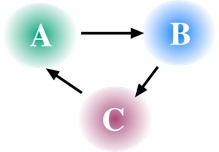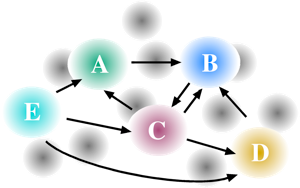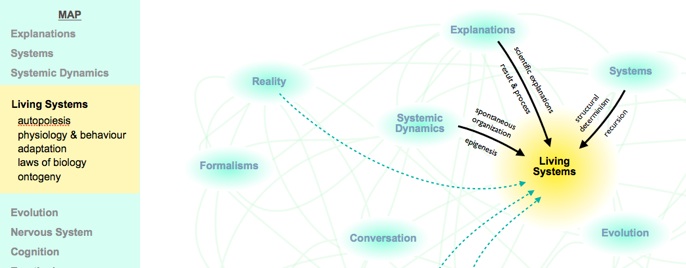a matrix of relations


This website is deeply grounded in the work of Humberto Maturana, with further elements from the work of others in Matriztica and elsewhere, and of course my own ideas. I would like to be clear that what I have presented, and indeed all that I can present to you, is only what I know, I have to claim responsibility for that. Further the world I live and understand has arisen through all of the many encounters I have experienced. Over my lifetime I have encountered many people, some as individuals, others known only through some of their works. I can and do thank them all for their intentional or unintentional contribution to me. Hence this website, although based on the biological, epistemological, ethical and daily life-based understanding that I have gained from Maturana’s deep work, I will be also present many other sources throughout this site.
I am fundamentally a biologist, a systems ecologist, and thus the notion of an ecology of ideas comes naturally, and the ecology of ideas becomes, reciprocally, a frame in which I can view the question of “what is an ecology”, or better “what have we distinguished when we see an ecology.” The same sort of reciprocal reflection applies also to the notion of “system”. What constitutes a matrix so that the elements are each autonomous yet each exist only due to the discontinuous but repeated interactions they have with each other?
And most relevant for me in the role of teacher... how does one present a matrix of ideas where each idea can only exist due to its relations with the other ideas? We don’t see this as the case in the world of ideas we grow up in, it is already a matrix, a coherent network, and we only occasionally notice some discontinuity or disharmony and become curious.
Lets say I want to explain an interesting and relevant idea B. But B doesn’t really make sense without first understanding A. So let’s begin with A, even though it might not yet be entirely clear why A matters. People can be patient, and after all, no idea is intrinsically interesting or boring. Whether it is interesting depends more on “how” one things about it than on “what it is”. So I try to show how A is interesting and meaningful on its own, and then go on to B, and do the same.


And once I have explained B, then we can go on to C ... and enjoy what that offers to our perspective. And furthermore, once C is grasped, it provides a deeper grounding for how A is seen, which in turn may deepens the understanding of B.
As you see it has become circular.
Then we add in D and E, and how they are connected,
and it beings to get complex.

As still more elements are added, it eventually becomes a coherent network. I caution students that it won’t really be until they have covered about 2/3 of the matrix that it all comes together as a whole. I can say this with assurance because year after year they tell me so. Furthermore, for many the ideas continue to percolate in their lives meaningfully from then on.
At one point I tried to detail out all the actual connections that I had understood between the various elements that I wished to eventually present on this website. Without even completing all the relevant “you need to know A before you fully understand B” kinds of connections, I realized that turning a systemic matrix into an explicit systems diagram was not fruitful. Our nervous systems are much more competent at making these connections than whatever we construct as a complex logic. This is so whether we express that understanding in a natural language or any of our programming or diagramming languages.


So I returned to an earlier poetic look at this complexity, and decided that I can regard the process of synthesis with trust. Trust in our own biological constitution, in our competence for generating relationships. The emotional fundaments of doing so are, I think love, trust and intimacy, as indeed is inherent in the biological and cultural matrix of human existence.
Where this content is intended as part of a course of studies, it would indeed be inappropriate to teach without doing so in integrity with what I am teaching.
However, I still had a puzzle. How do I organize a course, or a website so that the material is accessible in some sort of comprehensible way. Presenting a tangle is not useful.
Hence on this website I have created a map where the “species” of ideas form named communities of closely related ideas.” As in any natural community, this does not mean that the ideas are necessarily from the same evolutionary lineage, they may relate for a number of different reasons. Since this community is my construct, the relationships are those that have made sense to me.
You can see what I consider helpful to know about nearby communities if you click on any of the communities on the map. When you do so, you will see that community highlighted, and some of the ideas that are included in it appear highlighted in yellow on the turquoise navigation side bar. The black arrows that point to the community on the map indicate which ideas from other communities are particularly useful to know first. The dotted arrows suggest that your understanding of the community will deepen once you have also learned these.

Use the Map to see the Map.
Use the Navigation Bar to see the Content.
Each named group of ideas (community) will have its own navigation bar at the top of the page, and each page has a return button on the top left to bring you back to the map.
Enjoy!


1967: doing fieldwork for my PhD
All images and photographs on this site, unless otherwise credited, are produced by Pille Bunnell and may be used with attribution under a Creative Commons agreement.
